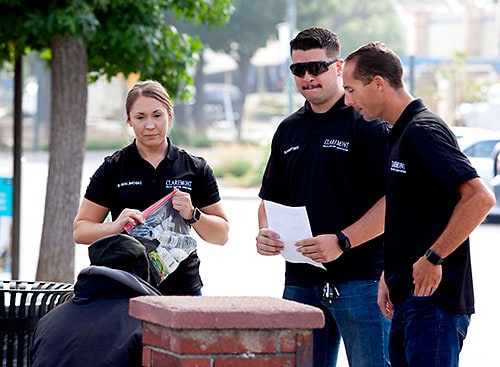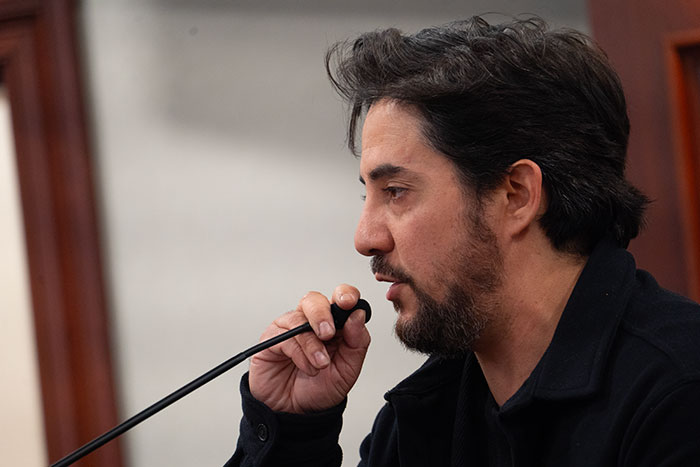Mission to help homeless

In the county with the nation’s highest homeless population, some may say it’s difficult to figure out how to help. But Claremont residents are counting the ways.
Forty-eight volunteers, Councilmembers Joe Lyons and Sam Pedroza included, gathered at the Joslyn Center Tuesday night to embark on the 2013 Greater Los Angeles Homeless Street Count sponsored by the Los Angeles Homeless Service Authority (LAHSA). Claremont volunteers joined with an estimated 5000 others from across the county in the biannual, 3-day tally, necessary to calculate the amount of funding to be provided for the next 2 years. For the past 2 decades, LAHSA has provided more than $70 million each year for programs providing shelter, housing and services to homeless persons in Los Angeles City and County. The count helps aid those efforts.
Understanding the number of homeless people in our community helps us address it, volunteers insist.
“We do it because everyone counts,” said Management Analyst Lauren Marshall, who helped orchestrate Claremont’s involvement in the tally, to the crowd of volunteers before the count began. “It is our responsibility to take note of and take care of the most vulnerable of our fellow citizens. The count is a great opportunity for us to really open our eyes and see homeless people in our community in a new light.”
From Tuesday, January 29 through Thursday, January 31, LAHSA deployed volunteers throughout the Greater Los Angeles area—minus Glendale, Long Beach and Pasadena, which will be conducting their own counts since their cities are so vast. Last year an estimated 48,000 homeless individuals were counted.
“The count really helps us know where the need is greatest and the best ways to help these people,” Ms. Marshall said. “It helps us use all of this money in the smartest way possible and we have to know what we are facing in order to take it on.”
While the count is required by the housing and urban development authority in order for an entity to receive funding, and is certainly beneficial in helping Claremont and other cities receive the necessary funding, Andrew Mohr of Occupy Claremont is concerned over the count’s accuracy. Mr. Mohr, who works with the Claremont Area Living Assistance Program (CALAP), says Claremont’s grand total—28 homeless individuals, 4 vehicles that appeared to be for homeless and 8 makeshift shelters—is lower than what the actual count is. He believes it is unintentionally deceptive.
“Something is better than nothing, but other than that I find [the numbers] misleading and unfortunately, if all the other cities have a similar experience, which I assume they are, we are going to be misleading our culture,” Mr. Mohr said.
He was hesitant to take part in the count when first approached by the city for other reasons.
“At first I was hesitant because I didn’t want to give away any of the places where people might be sleeping, even hanging out,” Mr. Mohr said, adding his concern that the count might be used for the wrong purposes, like tracking where the homeless are staying so that enforcement can pick them up later on.
“That was my biggest concern, but then I thought about the fact that hopefully the city will be getting money from the county for this and hopefully we can use this money to help our citizens without a place to live. Maybe some of that money can make it down to programs like ours, like CLAP, and can directly affect the issue.”
With the help of Occupy Claremont, the city of Claremont set out to make that happen. Volunteers were deployed to the streets of Claremont in teams of 2 to 4 equipped with flashlights, clipboards and maps in addition to their coats and gloves, protecting from the chilly night air. Each team was given a specific area to check, from Baseline to the downtown Village area to the Indian Hill Corridor and beyond. Each team had a leader, responsible for driving the designated route, along with a navigator, the leader’s second in command responsible for navigating the route and tallying the team’s results. Councilmember Sam Pedroza, a second time participant in Claremont’s homeless count, led the first team deployed, accompanied by navigator Sue Martin along with Bertha Godinez and David Chavez.
“We all get so caught up in our life routines and don’t realize, or really want to know, that there are people and families without shelter,” Mr. Pedroza shared. “To go out and actively seek out where people are camping out for the night, either in a car or makeshift encampment, we start to realize the extent of the homelessness problem.
“It’s like any major task,” Mr. Pedroza continued. “We need to first assess the scope or magnitude of the situation and then develop appropriate programs. I appreciate all those that took time and sleeping hours of their own to go out and help in this effort.”
Ms. Godinez, a custodial worker with Pitzer College, was the veteran of Mr. Pedroza’s group, a participant in Claremont’s street count for the past 3 counts. Ms. Godinez finds herself returning to the count time after time, called by her instincts as a passionate volunteer and mother. She recalls seeing a homeless mother and her 2 children while volunteering on her first count.
“One of the kids was crying, saying, ‘Mom, I’m hungry.’ It was eye-opening,” Ms. Godinez remembered. “I want to help in any little way that I can, to make sure they get the help they need, especially in this weather.”
Among the street counts’ benefits, including the possibility for funding, is the added awareness it brings to the community.
“We need to think of homelessness not so much as a theoretical issue but as people who, when we are sleeping comfortably in our beds, are sleeping in 32 degree weather. Or not really sleeping because it is impossible to sleep in 32 degree weather, just going in and out of a haze.”
The first step to solving the problem, he asserts, is realizing that it exists.
“We can get together and get involved collectively, and it needs to be a collective effort,” Mr. Mohr said, “And people need to walk away from the whole idea of ‘not in my backyard.’ That, to me, is the eleventh commandment.”
To find out more about LAHSA and the biannual homeless street count, visit www.theycountwillyou.org.
—Beth Hartnett
news@claremont-courier.com










0 Comments